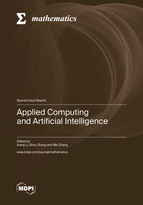Applied Computing and Artificial Intelligence
A special issue of Mathematics (ISSN 2227-7390). This special issue belongs to the section "Computational and Applied Mathematics".
Deadline for manuscript submissions: closed (31 October 2022) | Viewed by 45561
Special Issue Editors
Interests: industrial artificial intelligence; industrial big data; deep learning; fault diagnosis; prognosis; intelligent maintenance
Special Issues, Collections and Topics in MDPI journals
Interests: applied mathematics; nonlinear dynamics; control; information science; neural network; complex network system
Special Issues, Collections and Topics in MDPI journals
Interests: rotor dynamics; squeeze film damper; fault diagnosis; deep learning; mechanical engineering
Special Issues, Collections and Topics in MDPI journals
Special Issue Information
Dear Colleagues,
We are pleased to announce this Special Issue of the journal Mathematics entitled “Applied Computing and Artificial Intelligence”. This initiative focuses on advances in algorithmic research and practical applications of applied computing and artificial intelligence methods, which have been attracting growing interest in recent years due to their effectiveness in solving technical problems. The recent developments in applied mathematics have largely led to benefits in many industrial tasks in different fields, including the aerospace industry, manufacturing, transportation, energy, robotics, materials, informatics, etc. A large number of practical industrial problems have been well addressed, such as system condition monitoring, parameter identification, time-series data prediction, fault diagnosis, signal processing, dynamics analysis, system optimization, data-driven modeling, etc.
This Special Issue invites high-quality original research or review papers on recent advanced methods in applied computing and artificial intelligence to address the practical challenges in the related areas. The topics of interest are listed in the following, but not limited to:
- Applied computing
- Applied mathematics
- Neural networks
- Deep learning
- Parameter identification
- Dynamics
- System optimization
- Machine learning
- Control engineering
- Intelligent maintenance
- Computational methods
- Fault diagnosis
- Signal processing
- Rotor dynamics
- Prognosis
- Remaining useful life prediction
- Data mining
- Fractional differential equation
- Complex network system
- Stochastic dynamics
- Structural health monitoring
- Nonlinear dynamics and control
- Spacecraft dynamics
Dr. Xiang Li
Dr. Shuo Zhang
Dr. Wei Zhang
Guest Editors
Manuscript Submission Information
Manuscripts should be submitted online at www.mdpi.com by registering and logging in to this website. Once you are registered, click here to go to the submission form. Manuscripts can be submitted until the deadline. All submissions that pass pre-check are peer-reviewed. Accepted papers will be published continuously in the journal (as soon as accepted) and will be listed together on the special issue website. Research articles, review articles as well as short communications are invited. For planned papers, a title and short abstract (about 100 words) can be sent to the Editorial Office for announcement on this website.
Submitted manuscripts should not have been published previously, nor be under consideration for publication elsewhere (except conference proceedings papers). All manuscripts are thoroughly refereed through a single-blind peer-review process. A guide for authors and other relevant information for submission of manuscripts is available on the Instructions for Authors page. Mathematics is an international peer-reviewed open access semimonthly journal published by MDPI.
Please visit the Instructions for Authors page before submitting a manuscript. The Article Processing Charge (APC) for publication in this open access journal is 2600 CHF (Swiss Francs). Submitted papers should be well formatted and use good English. Authors may use MDPI's English editing service prior to publication or during author revisions.
Keywords
- applied mathematics
- neural networks
- dynamics
- control engineering
- intelligent maintenance
- computational methods
- fault diagnosis
- fractional differential equation
- complex network system
- stochastic dynamics
- nonlinear dynamics and control
- spacecraft dynamics








